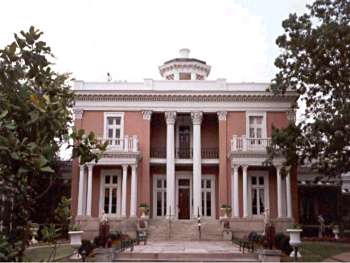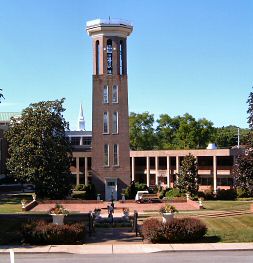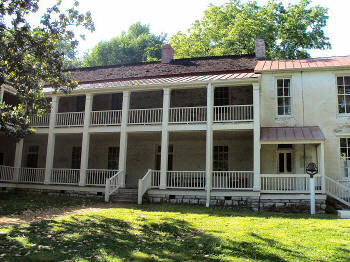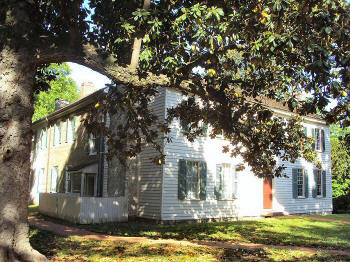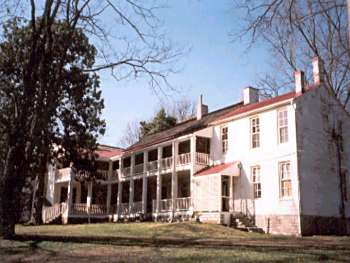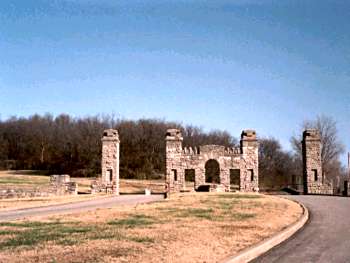|
(June 2013)
Enlarge
Travellers'
Rest.
Otherwise known as the Overton House, this is one of a very few period
structures on what was once the battlefield. Built by John Overton, one of
Andrew Jackson's law partners, the oldest part of the house dates to prior
to the War of 1812, as does Jackson's nearby much-better-known Hermitage.
Now a house museum, it mainly interprets the life and career of Overton
and his family, who continued to add to the original structure shown
below. Before the war, the Nashville & Decatur Railroad passed just a
little west of the house
By the time of Hood's approach to the outskirts of Nashville, his Army of
Tennessee had been too eviscerated at Franklin to do more than position
itself on hills overlooking the unassailable Federal works like Ft. Negley.
Hood made the Overton House his headquarters for the two-week period it
took Maj. Gen. George H. Thomas to prepare the expected counterattack to
drive the Confederates away. Hood hoped in vain any such move would so
weaken or derange Federal forces so as to make them vulnerable to a
slashing counterattack, something he utterly failed to recognize his army
was no longer capable of. It's easy to imagine the tense staff meetings
and dinners held here in the dining room of which Mrs. Overton was so
proud to have served so many distinguished Confederate guests!
James Neel photo |
|
(June 2013)
Enlarge
Travellers'
Rest
 Travellers' Rest Interpretive Marker: Courtesy
of Andy Creighton, TN
Travellers' Rest Interpretive Marker: Courtesy
of Andy Creighton, TN
James Neel photo |
|
(1997) Travellers' Rest
David McMinn photo |
|
(1997) Fort Negley ---- Not
much is known about this landlocked fort; however,
some believe that the opening shots of the Battle of Nashville were fired
from here. The fort was part of the Union army�s
outer perimeter south of Nashville
David McMinn photo
 Seven pages of Fort Negley photos, courtesy
of Andrew Turnier, NC
Seven pages of Fort Negley photos, courtesy
of Andrew Turnier, NC
|
|
(June 2013)
Enlarge State Capitol Building and War
Memorial Plaza as seen from Nashville's 1906 Hermitage Hotel
At the beginning of the Civil War, Tennessee boasted one of the newest,
largest, and most beautiful State Capitals in the Nation. Completed in
1859 immediately before secession and the outbreak of hostilities, it was
so renowned it was featured on new Confederate currency as a symbol of
Southern pride, power and culture. It was therefore a terrible blow to the
South when Nashville fell so early in the war to the Army of the Ohio led
by Maj. Gen. Don Carlos Buell at the end of March, 1862. From that time,
Nashville remained in Federal hands and served as the capital of the
restored pro-Union government of Military Governor and
politically-appointed Brig. Gen. Andrew Johnson
Courtesy of James Neel |
|
(June 2013)
Enlarge The classically-inspired
building is deceptively larger than it appears at first glance. From here,
"Tennessee" Johnson and his successor, Knoxville Unionist newspaperman
William G. "Parson" Brownlow, ruled over a far-flung "empire", often with a
heavy hand. Ever fearing a Confederate resurgence, Federal occupation troops
heavily fortified the building, even arming it with 30-pounder Parrott
rifled cannon! A garrison was encamped just outside the strong-but-makeshift
government "fortress", remaining there until well after the one vain
attempt, that by John Bell Hood's severely outnumbered and outclassed army
in December, 1864
Courtesy of James Neel |


